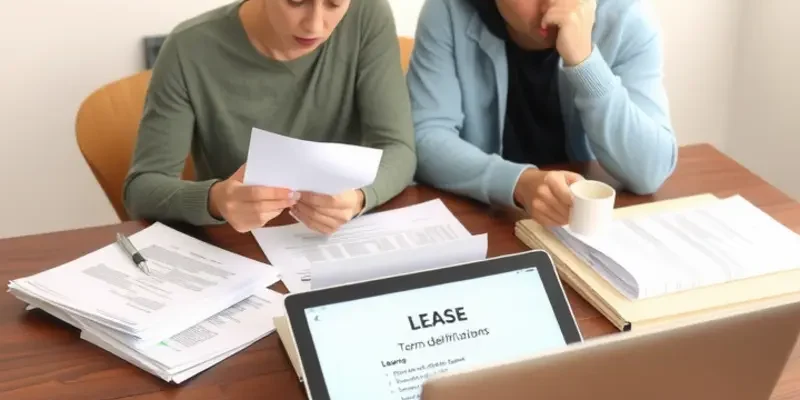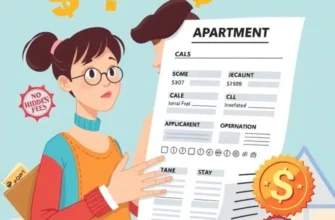Renting your first apartment is like throwing a huge party—you want everything to be perfect, but it often spirals into a series of misadventures. Whether you’re a young professional stepping into the adult world or a couple seeking a cozy abode, the journey can be filled with excitement and anxiety. From negotiating a lease to choosing the right location, there are many decisions to make—and just as many opportunities for mishaps. Picture this: you finally get your keys only to discover that the rental doesn’t accept pets, or worse, you’ve signed a lease without understanding the terms. Fear not! This guide highlights some of the most common mistakes first-time renters make, along with practical suggestions to help you steer clear of disaster and ensure your new place feels like home. Let’s roll up our sleeves and dive into the world of renting smartly!
Leasing Lingo: Don’t Get Lost in Translation

Reading and understanding the terms of your lease can save you from unexpected surprises. Leases often contain legal jargon, but knowing the essential terms will help you feel confident and informed.
Let’s start with rent increases. Most leases specify how and when rent may be increased. It’s crucial to know whether your contract includes a fixed-rate term, where rent remains consistent, or if it allows for periodic increases. Look for clauses that describe when the landlord can increase rent and by how much. Awareness of this can prevent financial strain and allow for better financial planning.
Next, examine the pet policy. Even if you don’t own a pet now, future decisions might hinge on this clause. Policies can vary widely—some lease agreements impose restrictions on breed and size, while others charge a pet deposit or additional monthly fees. Understanding these terms can help avoid fines or potential breaches of your lease.
Every lease will detail maintenance responsibilities. These outline what the landlord covers and what you, as a tenant, must handle. Generally, landlords take care of major repairs, but tenants are often responsible for minor fixes. It’s essential to clarify who is responsible for tasks like light bulb replacements or clogged drains. To identify what’s expected of you, read the terms carefully and consider discussing any unclear sections with your landlord.
Another key term is the security deposit. This deposit protects the landlord if the property is damaged or if the lease is broken. Be aware of how much is required, when it’s due, and the conditions for refund upon lease termination. Keep a record of the apartment’s condition during move-in to ensure you reclaim your deposit later.
Lease terminations and renewals are vital to understand. These clauses inform you how to correctly end the lease or opt for renewal. They usually require advance notice, often 30 to 60 days. Failing to comply could result in additional charges or loss of deposit. Be proactive about renewal intentions to avoid penalties.
Lastly, focus on rules for alterations. If you plan to make changes, such as adding shelves or painting walls, check the lease first. Some leases permit minor alterations with approval, while others prohibit them entirely. Ignoring these rules can lead to deductions from your deposit when you move out.
For a further understanding of how to handle apartment responsibilities, including maintenance, you can explore our guide on apartment laundry maintenance. This resource provides insights into maintaining a rental property while ensuring you comply with lease agreements.
By investing time in deciphering your lease, you protect your rights and prevent misunderstandings. A well-understood lease lays the foundation for a smooth renting experience.
Location, Location, Location: Picking Wisely

Navigating the rental landscape provides both excitement and challenges, especially when determining the best location for your first apartment. While selecting a place that fits your budget is crucial, the surrounding neighborhood can vastly influence your quality of life. It’s not just about square footage or modern fixtures; it’s also about what lies beyond the front door.
Commute and Convenience are powerful determinants of your daily satisfaction. Imagine saving 30 minutes every day by living closer to work or school. That extra time can be spent relaxing or engaging in activities you truly enjoy. Consider the proximity of public transport options if you don’t own a car. A nearby bus stop or train station can significantly ease your daily travels. Don’t forget to check out traffic patterns too; a peaceful street can transform into a congested nightmare during rush hour.
Equally important is the availability of essential amenities. You might find the perfect apartment, but it’s a hassle to travel miles for groceries. Ideally, opt for a location where basic necessities—like supermarkets, pharmacies, and healthcare facilities—are easily accessible. Walking or a short drive to perform your weekly errands can simplify your day-to-day life.
When you start to consider your social life, the neighborhood’s vibe becomes important. Look for areas that match your lifestyle. If you thrive in a bustling atmosphere with numerous entertainment options, seek neighborhoods known for active nightlife. Access to cafes, bars, and cultural venues can offer a great quality of life, but ensure that they align with your preferences. Balancing fun with a community’s noise level is essential for peace of mind.
For those who prioritize leisure and outdoor activities, assessing the proximity to parks and recreational areas is essential. Having a nearby green space can be a welcoming refuge for exercise and relaxation. It also contributes positively to your mental well-being.
Safety should never be overlooked. Investigate the neighborhood’s crime rate and consider its reputation among residents. Visiting the area at different times of day can provide a real sense of how it feels at night versus during the day. Connecting with potential neighbors might reveal insights that are not immediately obvious.
One often ignored yet critical aspect is the community’s overall vibe and culture. Spend time in cafes, visit local events, and walk through different streets to get a genuine feel of the area. How do you feel when you’re there? Does it feel welcoming or alien? Seeking insights from local guides such as the best areas to rent in different cities can also provide valuable perspectives.
Renting your first apartment is a doorway to a new chapter in life. Selecting an ideal location that fulfills both practical and personal needs can make your transition smoother and more enriching. You’ll not only be choosing a building but a lifestyle that supports your future growth and happiness.
Final words
Renting your first apartment should be an exciting leap into independence, not a bumpy ride filled with costly errors. By understanding leasing terms and carefully choosing your location, you’re one step closer to turning that empty space into a cozy nest. Each choice plays a vital role in shaping your new chapter in life—avoid the common pitfalls, and you’ll not only celebrate your newfound freedom but also build memories that’ll last a lifetime. Remember, knowledge is your best friend in the world of renting!









